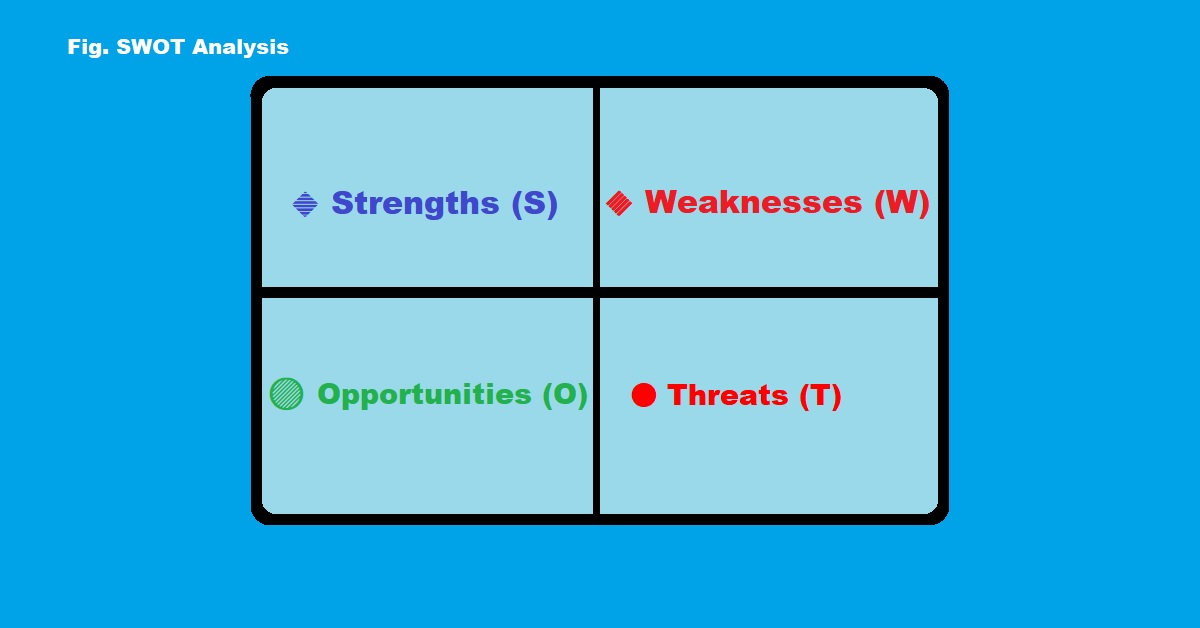Understanding SWOT Analysis: A Strategic Tool for Business Decision-Making. It makes balanced and comprehensive way to examine any business scenario to understanding internal strengths and weaknesses along with external opportunities and threats is crucial.
📌 SWOT Analysis was developed in the 1960s by Albert Humphrey, a management consultant at the Stanford Research Institute (SRI) in the United States.
SWOT Analysis in Business:
In the competitive world of business strategy, SWOT analysis stands out as a simple yet powerful framework used to evaluate an organization’s internal and external environment. SWOT Analysis helps decision-makers map out the Strengths, Weaknesses, Opportunities, and Threats related to a business, product, or strategy.
This structured method aids in strategic planning, problem-solving, and identifying areas for growth and risk management. By examining both internal factors (strengths and weaknesses) and external factors (opportunities and threats), businesses can align their capabilities with market realities.
The Four Elements of SWOT Analysis:
- Strengths (S)
- Weaknesses (W)
- Opportunities (O)
- Threats (T)
🔷 Strengths (S)
Strengths refer to the internal attributes, capabilities, and resources that give an organization a competitive edge in the market. These are areas where the business excels or possesses advantages that can be leveraged for strategic gain.
Examples may include:
- A strong brand identity or reputation
- Proprietary technologies or patents
- Skilled leadership and experienced workforce
- Operational efficiencies or cost advantages
- High customer satisfaction and loyalty
Essentially, strengths are the building blocks of long-term success and competitive positioning.
🔶 Weaknesses (W)
Weaknesses are internal limitations or areas of underperformance that hinder an organization’s ability to compete effectively. Identifying weaknesses is crucial for risk management and continuous improvement.
Examples may include:
- Lack of innovation or outdated technology
- Gaps in product quality or service delivery
- Inefficient internal processes
- Poor brand awareness or limited market reach
- Inadequate talent or leadership gaps
By addressing these areas proactively, a company can reduce vulnerabilities and enhance resilience.
🟢 Opportunities (O)
Opportunities are external trends, shifts, or changes in the business environment that can be exploited for growth, expansion, or value creation. These can emerge from market developments, technological advances, regulatory reforms, or evolving customer preferences.
Examples may include:
- Entry into emerging markets or customer segments
- Technological innovations enabling new offerings
- Strategic partnerships or joint ventures
- Favorable policy or regulatory changes
- Changing consumer behavior that aligns with the company’s value proposition
Effectively capitalizing on opportunities requires agility, vision, and strategic foresight.
🔴 Threats (T)
Threats are external factors or challenges that may adversely impact an organization’s performance, stability, or competitiveness. These elements are typically beyond a company’s control but must be anticipated and managed.
Examples may include:
- Aggressive competition or market saturation
- Economic downturns or financial crises
- Disruptive innovations from new entrants
- Shifting consumer preferences away from the core offering
- Regulatory changes increasing operational burdens
A strong strategic plan includes contingencies to mitigate these risks.
Example: SWOT Analysis of a Mid-Sized Coffee Chain – “BeanBrew Café”
Strengths:
- Brand Loyalty: With over 50 locations across metro cities, BeanBrew has a strong, loyal customer base.
- Sustainable Sourcing: The brand sources its coffee from fair-trade certified farms, enhancing its ethical appeal.
- Employee Training Programs: High-quality service stems from its well-developed barista training modules.
Weaknesses:
- Limited Online Presence: While competitors offer robust apps and delivery services, BeanBrew’s digital capabilities are underdeveloped.
- Dependency on Urban Markets: The business is heavily concentrated in cities, making it vulnerable to urban economic shifts.
- High Operational Costs: Premium locations and manual processes increase expenses.
Opportunities:
- Expansion into Tier-2 Cities: Growing disposable income in smaller cities presents a market entry opportunity.
- Mobile App Development: Launching a user-friendly app for ordering and loyalty points could increase convenience and revenue.
- Partnership with Food Delivery Apps: Could tap into a wider customer base and boost sales.
Threats:
- Intense Competition: Global giants like Starbucks and agile startups are expanding aggressively in the same regions.
- Economic Downturn: Consumer spending on non-essential items like café coffee can drop in a slowdown.
- Supply Chain Disruptions: Global instability and climate change can affect coffee production.
Conclusion
SWOT analysis provides a balanced and comprehensive way to examine any business scenario. Whether it’s a multinational company planning global expansion or a startup launching a new app, understanding internal strengths and weaknesses along with external opportunities and threats is crucial. Any one who learn to apply SWOT with insight and creativity will be better equipped to navigate the complexities of modern business environments.
🔗 Stay Connected with Management Plus for more Article!

